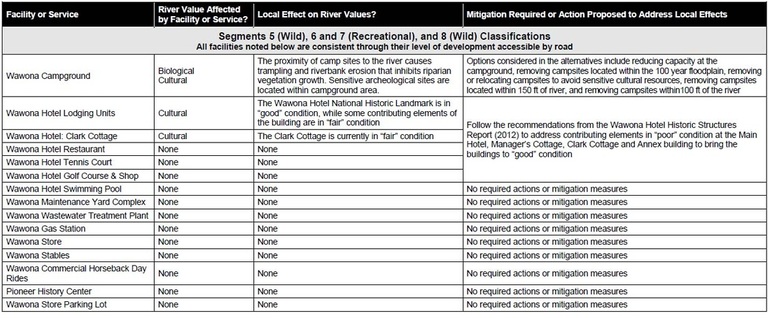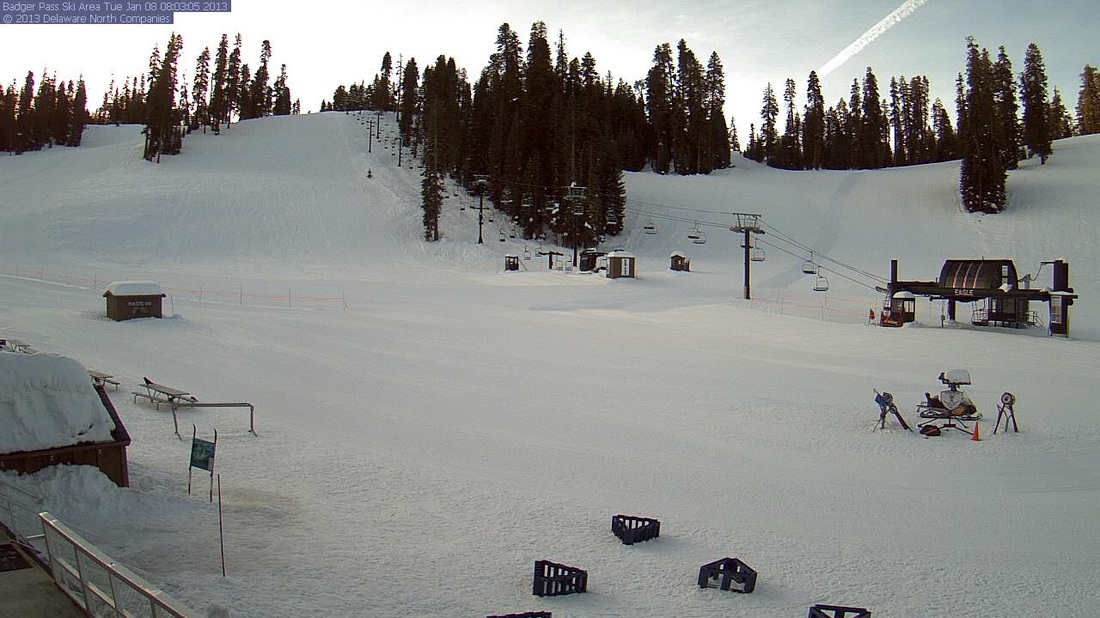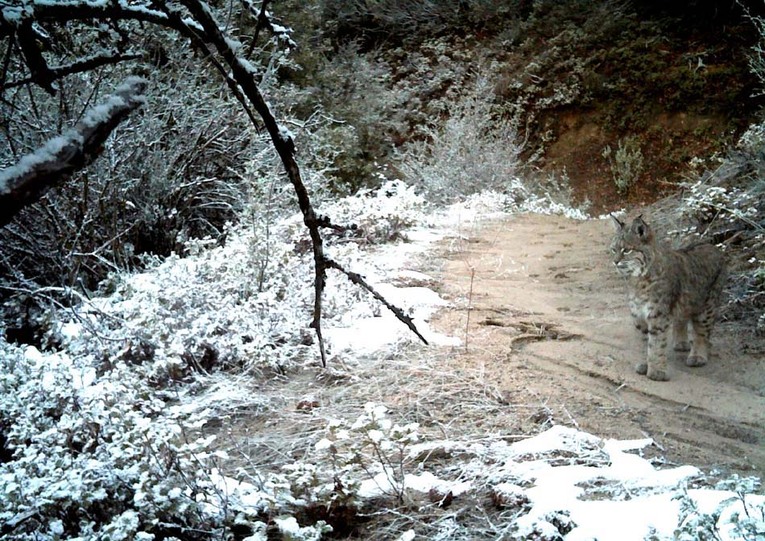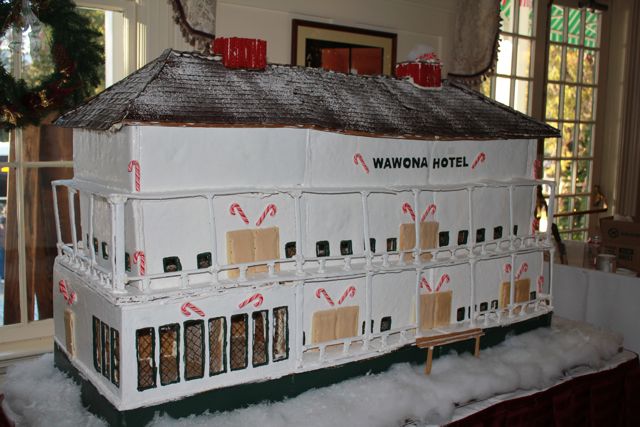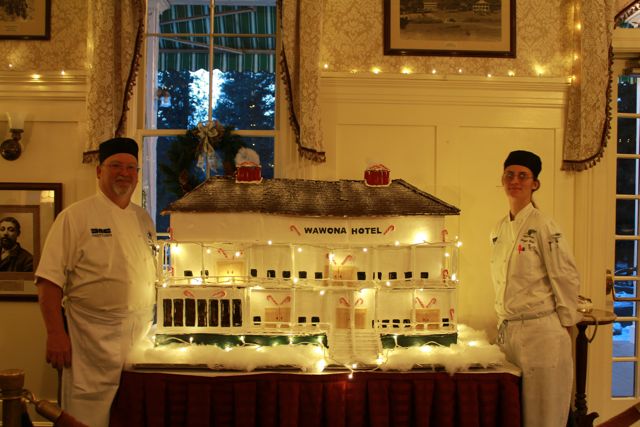WawonaNews.com - January 2013
Ranger couple spend winter in rugged high country
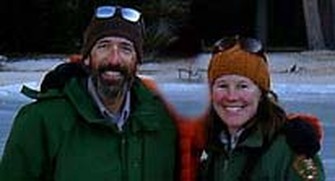
Rob and Laura
Tuesday, Jan. 08, 2013 | 08:16 PM
Two rangers are writing fascinating blogs (http://www.nps.gov/yose/blogs/tmconditions.htm) about the rugged high-country winter in Yosemite National Park -- below-zero nights, blizzards, animal tracks in the snow.
The rangers are a married couple, Laura and Rob Pilewski. They are at Tuolumne Meadows for the winter, a job some would consider a plum.
The commute traffic clearly is no problem in the snow-covered landscape at 8,000 to 10,000 feet in elevation. Tioga Road is closed for the winter. They patrol on skis.
From their accounts, it seems clear that the Pilewskis love their work.
Here's what they posted about New Year's:
"Most of our week was spent on Tioga Pass. We saw a very ambitious set of coyote tracks that explored Gaylor Peak ridge all the way down to Tioga Lake through very deep snow. Weasel and pine marten tracks were seen between there and Tuolumne as well. The most notable sighting was a colorful flock of over 20 male (red) and female (yellow-green) red crossbills flying over Dana Meadow at sunset, peacefully ringing in the New Year as they passed overhead."
If you're an outdoor or mountain enthusiast, that beats a Times Square celebration by quite a bit.
But at 10,000 feet, the Sierra can be pretty unforgiving in December and January. The latest update says the temperature dropped to minus 13 one night after Christmas.
The Pilewskis are living in a cabin at Tuolumne Meadows, park officials said. Often the cabin has power. Sometimes, it doesn't.
The rangers ski back to civilization occasionally for supplies, but mostly they are working. They check the area utilities, survey wildlife, assist with measuring the snowpack and watch over the park's buildings in the high country. What a job.
Two rangers are writing fascinating blogs (http://www.nps.gov/yose/blogs/tmconditions.htm) about the rugged high-country winter in Yosemite National Park -- below-zero nights, blizzards, animal tracks in the snow.
The rangers are a married couple, Laura and Rob Pilewski. They are at Tuolumne Meadows for the winter, a job some would consider a plum.
The commute traffic clearly is no problem in the snow-covered landscape at 8,000 to 10,000 feet in elevation. Tioga Road is closed for the winter. They patrol on skis.
From their accounts, it seems clear that the Pilewskis love their work.
Here's what they posted about New Year's:
"Most of our week was spent on Tioga Pass. We saw a very ambitious set of coyote tracks that explored Gaylor Peak ridge all the way down to Tioga Lake through very deep snow. Weasel and pine marten tracks were seen between there and Tuolumne as well. The most notable sighting was a colorful flock of over 20 male (red) and female (yellow-green) red crossbills flying over Dana Meadow at sunset, peacefully ringing in the New Year as they passed overhead."
If you're an outdoor or mountain enthusiast, that beats a Times Square celebration by quite a bit.
But at 10,000 feet, the Sierra can be pretty unforgiving in December and January. The latest update says the temperature dropped to minus 13 one night after Christmas.
The Pilewskis are living in a cabin at Tuolumne Meadows, park officials said. Often the cabin has power. Sometimes, it doesn't.
The rangers ski back to civilization occasionally for supplies, but mostly they are working. They check the area utilities, survey wildlife, assist with measuring the snowpack and watch over the park's buildings in the high country. What a job.
$235 million renovation plan for Yosemite Valley unveiled
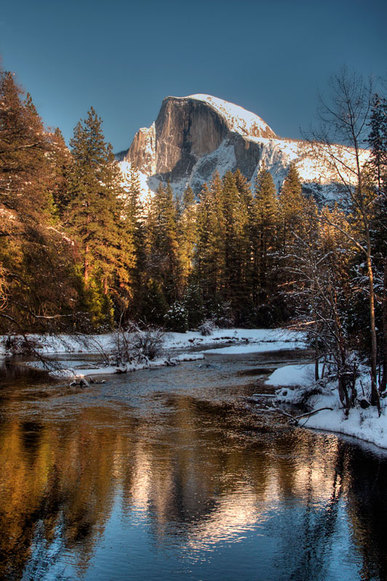
By Mark Grossi - The Fresno Bee
Tuesday, Jan. 08, 2013 | 10:01 AM Modified Tue, Jan 08, 2013 10:26 AM
The National Park Service is calling for a $235 million renovation of world-renowned Yosemite Valley that adds parking, builds a pedestrian underpass near Yosemite Falls and limits the number of people who can visit paradise.
The projects are part of the embattled draft Merced River Plan, which was released Tuesday. Yosemite Lodge, which could have been eliminated under other options, will be retained. But popular Curry Village Ice Rink as well as bicycle and raft rentals will go away (Visitors would still be allowed to use their own rafts on the Merced River but would be directed to specific areas for access to keep steep banks from being trampled and eroded.)
The public will have until April 18 to comment on the plan. By court order, Yosemite National Park must have a final plan in place by late July.
Two other versions of the plan went through more than a decade of litigation before the park was ordered to write a third one from scratch. It has taken three years and required more than $1 million in research, said Kathleen Morse, Yosemite chief of planning.
"It's the most extensive outreach I've seen," said Morse, a 25-year veteran of public service.
The preferred alternative in the plan has a limit of 19,900 visitors per day for glacially sculpted Yosemite Valley, a seven-square-mile area surrounded by soaring granite cliffs and eye-popping waterfalls.
Day-use parking would increase from 2,337 spaces to 2,448. Camp sites would expand from 466 to 640.
The pedestrian underpass at Northside Drive would allow visitors to walk from Yosemite Lodge to Yosemite Falls without disrupting traffic.
Near Yosemite Village, a sprawling day-use parking lot would be move 150 feet away from the Merced River.
The projects in the plan would be spread over the next 15 to 20 years, Morse said. The money would come from several Yosemite income sources, including entrance and concessions franchise fees.
Tuesday, Jan. 08, 2013 | 10:01 AM Modified Tue, Jan 08, 2013 10:26 AM
The National Park Service is calling for a $235 million renovation of world-renowned Yosemite Valley that adds parking, builds a pedestrian underpass near Yosemite Falls and limits the number of people who can visit paradise.
The projects are part of the embattled draft Merced River Plan, which was released Tuesday. Yosemite Lodge, which could have been eliminated under other options, will be retained. But popular Curry Village Ice Rink as well as bicycle and raft rentals will go away (Visitors would still be allowed to use their own rafts on the Merced River but would be directed to specific areas for access to keep steep banks from being trampled and eroded.)
The public will have until April 18 to comment on the plan. By court order, Yosemite National Park must have a final plan in place by late July.
Two other versions of the plan went through more than a decade of litigation before the park was ordered to write a third one from scratch. It has taken three years and required more than $1 million in research, said Kathleen Morse, Yosemite chief of planning.
"It's the most extensive outreach I've seen," said Morse, a 25-year veteran of public service.
The preferred alternative in the plan has a limit of 19,900 visitors per day for glacially sculpted Yosemite Valley, a seven-square-mile area surrounded by soaring granite cliffs and eye-popping waterfalls.
Day-use parking would increase from 2,337 spaces to 2,448. Camp sites would expand from 466 to 640.
The pedestrian underpass at Northside Drive would allow visitors to walk from Yosemite Lodge to Yosemite Falls without disrupting traffic.
Near Yosemite Village, a sprawling day-use parking lot would be move 150 feet away from the Merced River.
The projects in the plan would be spread over the next 15 to 20 years, Morse said. The money would come from several Yosemite income sources, including entrance and concessions franchise fees.
Wawona-related portions of the Merced River Plan draft
Facilities and services analysis
River values and their management
In Segments 6 and 7 in Wawona, the South Fork Bridge was damaged during the 1997 flood and replaced in
2006 with a new bridge without piers in the river channel. As established in the WSRA Section 7
determination process, an evaluation for direct and adverse effects by the new bridge found no significant
impediment to the free-flowing condition of the river during most flow conditions. In addition, a water
intake structure at Swinging Bridge, diverting water to the Wawona Water Treatment Plant, remains.
Water for domestic consumption in Wawona (Segment 7) is taken directly from the South Fork Merced
River, in Segment 6. In most years, there is adequate flow for the withdrawals, but in dry years like 2012 river
levels can reach critically low levels. In 1987, the NPS implemented the Wawona Water Conservation Plan,
which set the rate of diversion from the Wawona water intake at 0.59 cubic feet per second (NPS 1987)
(water is diverted for domestic and irrigation uses). To protect instream flows for aquatic habitat, the plan
enacts mandatory water conservation whenever the river reaches flows of less than 6 cubic feet per second.
At flows of less than 6 cubic feet per second, diversions were limited to 10% of the river flow. The plan
adequately protects the river’s aquatic invertebrates and other life forms during such drought years, but
increases in such withdrawals could harm native fauna (Holmquist and Waddle 2012). All alternatives
would continue the conservation plan.
In Segments 5 and 8, current free-flowing conditions remain the same as in 1987 at the time of river’s
designation. There are no human-caused impediments within the river channel.
2006 with a new bridge without piers in the river channel. As established in the WSRA Section 7
determination process, an evaluation for direct and adverse effects by the new bridge found no significant
impediment to the free-flowing condition of the river during most flow conditions. In addition, a water
intake structure at Swinging Bridge, diverting water to the Wawona Water Treatment Plant, remains.
Water for domestic consumption in Wawona (Segment 7) is taken directly from the South Fork Merced
River, in Segment 6. In most years, there is adequate flow for the withdrawals, but in dry years like 2012 river
levels can reach critically low levels. In 1987, the NPS implemented the Wawona Water Conservation Plan,
which set the rate of diversion from the Wawona water intake at 0.59 cubic feet per second (NPS 1987)
(water is diverted for domestic and irrigation uses). To protect instream flows for aquatic habitat, the plan
enacts mandatory water conservation whenever the river reaches flows of less than 6 cubic feet per second.
At flows of less than 6 cubic feet per second, diversions were limited to 10% of the river flow. The plan
adequately protects the river’s aquatic invertebrates and other life forms during such drought years, but
increases in such withdrawals could harm native fauna (Holmquist and Waddle 2012). All alternatives
would continue the conservation plan.
In Segments 5 and 8, current free-flowing conditions remain the same as in 1987 at the time of river’s
designation. There are no human-caused impediments within the river channel.
Wawona Archeological District
The Wawona Archeological District is absent of adverse effects, degradation, and management concerns
(conditions that exceed management triggers). Management considerations are present. To address
management considerations, the NPS would remove seven campsites that cause impacts to the Camp A.E.
Wood archeological site, and initiate a variety of actions to address specific considerations including removal
of informal trails, non-essential roads, and infrastructure that impact archeological sites under Alternatives 2-6.
To prevent these considerations, or others, from redeveloping, the NPS would monitor the condition of the
ORV, and take specific actions should specific trigger points be reached. These trigger points are selected to
inform managers well in advance of adverse effects or degradation impacts on this ORV.
(conditions that exceed management triggers). Management considerations are present. To address
management considerations, the NPS would remove seven campsites that cause impacts to the Camp A.E.
Wood archeological site, and initiate a variety of actions to address specific considerations including removal
of informal trails, non-essential roads, and infrastructure that impact archeological sites under Alternatives 2-6.
To prevent these considerations, or others, from redeveloping, the NPS would monitor the condition of the
ORV, and take specific actions should specific trigger points be reached. These trigger points are selected to
inform managers well in advance of adverse effects or degradation impacts on this ORV.
Wawona historic resources
The Wawona Historic Resources ORV is absent of adverse effects and degradation. A management concern
is present, as are some management considerations; NPS will follow the recommendations of the recent
historic structures report for the Wawona Hotel to correct these problems and return the ORV condition to
the management standard. To prevent future impacts, the NPS will monitor the condition of the ORV, and
take specific actions should conditions exceed trigger points. Trigger points are selected to inform managers
well in advance of adverse effects or degradation impacts on the bridge and hotel complex.
is present, as are some management considerations; NPS will follow the recommendations of the recent
historic structures report for the Wawona Hotel to correct these problems and return the ORV condition to
the management standard. To prevent future impacts, the NPS will monitor the condition of the ORV, and
take specific actions should conditions exceed trigger points. Trigger points are selected to inform managers
well in advance of adverse effects or degradation impacts on the bridge and hotel complex.
SUMMARY OF KEY USER CAPACITY MANAGEMENT INFORMATION: WAWONA
If you would like to send the Park Administration a comment regarding the Merced River Plan, click the button below.
Yosemite has scheduled an extended 90-day comment period from Jan. 18-April 18, 2013. Throughout this time, public meetings are scheduled in various locations to allow multiple opportunities for the public, Yosemite's interdisciplinary planning team, and subject-matter experts to interact. You have helped us create a promising first draft, and we ask for your feedback regarding how to improve the plan. Comments are due no later than 90 days after the publication of the EPA notice in the Federal Register. The Planning Division requests the public submit comments online through the Planning, Environment, and Public Comment (PEPC) site (click the button below)
New webcam at Badger Pass
Have you ever wondered what the snow and weather conditions were at Badger Pass? Now you can see for yourself. A new webcam has been set up facing the slopes from the top deck of the building. The web cam takes images approximately every 60 seconds. We have added a permanent link to it from our "Yosemite area webcams" section, on the top menu of this page.
Finding of No Significant Impact available for the Half Dome Trail Stewardship Plan
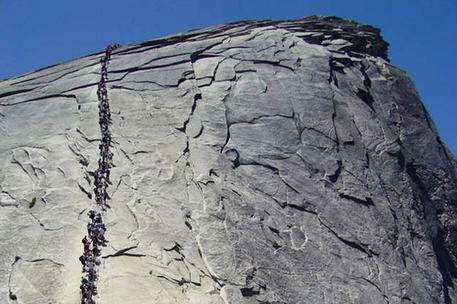
Yosemite National Park announces the signing of the Half Dome Trail Stewardship Plan Finding of No Significant Impact (FONSI). This document records the decision of Yosemite National Park to adopt a new day-use permit program for the Half Dome Trail which includes continued use of the Half Dome cables. Hiking to the top of Half Dome is one of the most popular hikes in Yosemite National Park. The iconic granite monolith, at 8,842 feet above sea level, attracts people from all over the world who attempt to climb to the summit. Most visitors ascend Half Dome via the cables, which are typically in place from mid-May through mid-October.
In 1964, Congress passed the Wilderness Act, creating the National Wilderness Preservation System. In 1984, approximately 95% of Yosemite National Park, including Half Dome and the Half Dome Trail, was designated as Wilderness through the California Wilderness Act of 1984. The Selected Action reduces congestion and improves conditions for public safety, while providing a range of wilderness experiences. Under the Selected Action, Yosemite National Park will retain the cable system and implement day-use limits through a permit system, managing for a target of 300 people on the Half Dome Trail per day.
The Selected Action is generally the same as the Preferred Alternative in the Environmental Assessment (EA) that was released for public review in January 2012. The park received a total of 1,649 comment letters during the 52-day public comment period. A wide range of comments were received: some urging the park to reconsider installing a third cable, some supporting the Preferred Alternative, and others supporting the removal of the cables altogether. Commenters sought clarification on visitor use studies, safety measures, commercial use, wilderness character, and permit allocation. There are some clarifications and corrections to the EA based on public comment, mainly in the area of commercial use. These corrections are included in an Errata to the EA.
Applications for permits to hike the trail are available from March 1 through March 31, 2013. The park will allocate permits through a preseason lottery, a two-day in advance lottery, and as part of the Wilderness Permit process. Details regarding the lotteries and the wilderness process can be found at the park’s website at www.nps.gov/yose/planyourvisit/hdpermits.htm. The lottery will be conducted through www.recreation.gov.
The FONSI and errata sheets completing the decision-making process are available online at: www.nps.gov/yose/parkmgmt/hdp_information.htm. Requests for hardcopies or CD-ROMs of the FONSI, available on a limited basis, can be submitted to: Superintendent, Yosemite National Park, and Attn: Half Dome Trail Stewardship Plan, P.O. Box 577, Yosemite, CA 95389.
Lynx spotted on Wawona trail
Wawona Hotel staff creates gingerbread replica
In early December Joe Alfano, General Manager of the Wawona Hotel in Yosemite National Park, challenged his management staff to come up with several activities for the hotel guests to participate in for the “12 Day’s of Christmas” celebration. Restaurant Manager Kristina Garrett, Front Desk Manager Leila Montero and Executive Housekeeper, Lisa McKee came up with several arts and crafts activities that were very well received. The Executive Chef, Dwayne McFann and his Sous Chef, Jackie Zehl, facilitated a cooking demonstration to show the hotel guests how to prepare Salmon Cakes with a Black Bean Corn Salsa and a Diakon Sprout and Jicama Salad as well as a dessert of Banana’s Foster served in a Tuille cup.
General Manager, Joe Alfano, also challenged his culinary team to make a gingerbread house display. And the “Jewel in the Crown” of the holiday celebration turned out to be the replica of the Wawona Hotel created entirely out of gingerbread! It took the culinary team 8 days to complete the replica for the presentation in the lobby on Christmas Eve morning. Chefs Dwayne McFann and Jackie Zehl unveiled a 6-foot long, 2-½ foot wide, and 3-½ foot tall replica of the 137 year old hotel, making Joe’s vision a reality by using over 200 pounds of gingerbread and royal icing.
The hotel guests, spending their Holidays at Wawona to enjoy the festivities in the lobby were thrilled with the unveiling of the gingerbread version of the Wawona Hotel. The gingerbread hotel will be on display in the Main Lobby of the Wawona Hotel through the holiday season and into the new year, for all to enjoy.
General Manager, Joe Alfano, also challenged his culinary team to make a gingerbread house display. And the “Jewel in the Crown” of the holiday celebration turned out to be the replica of the Wawona Hotel created entirely out of gingerbread! It took the culinary team 8 days to complete the replica for the presentation in the lobby on Christmas Eve morning. Chefs Dwayne McFann and Jackie Zehl unveiled a 6-foot long, 2-½ foot wide, and 3-½ foot tall replica of the 137 year old hotel, making Joe’s vision a reality by using over 200 pounds of gingerbread and royal icing.
The hotel guests, spending their Holidays at Wawona to enjoy the festivities in the lobby were thrilled with the unveiling of the gingerbread version of the Wawona Hotel. The gingerbread hotel will be on display in the Main Lobby of the Wawona Hotel through the holiday season and into the new year, for all to enjoy.
Search on for plane that disappeared over North Dome
YOSEMITE NATIONAL PARK, Calif. (AP) — Officials say a small plane flying from Santa Barbara to Mammoth Lakes has been reported missing and left the radar over Yosemite National Park. Yosemite spokeswoman Kari Cobb says the family of the pilot, who was the only person aboard, reported him missing Tuesday morning. |
|
The family says he departed Santa Barbara at about 12:30 p.m. Monday.
Cobb says despite assistance from the Air Force and state emergency services, only minimal searching was possible Tuesday because of tough weather conditions.
The plane went off the radar as it flew over the North Dome area of the park, and the nearest road is closed for the season, adding another challenge to the search.
Cobb says the pilot is from the Santa Barbara area. His name has not been released.
Cobb says despite assistance from the Air Force and state emergency services, only minimal searching was possible Tuesday because of tough weather conditions.
The plane went off the radar as it flew over the North Dome area of the park, and the nearest road is closed for the season, adding another challenge to the search.
Cobb says the pilot is from the Santa Barbara area. His name has not been released.
New California law puts end to hunting bears and bobcats with hounds
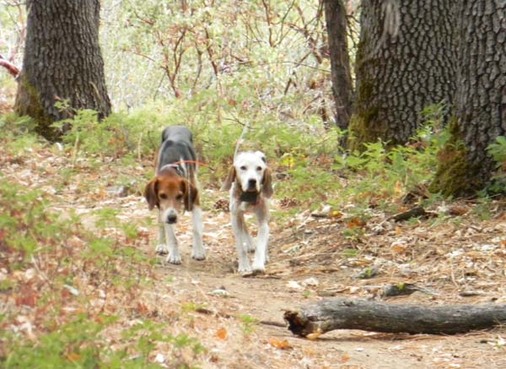
Stranded hunting dogs spotted in the Wawona area earlier this year
By DON THOMPSON | Associated Press | Dec 25, 2012
SACRAMENTO, Calif. – Gary Ramey and his adult daughter traveled 2,500 miles to hunt California bears with hounds last month, eager to take part in what he calls a time-honored tradition.
It's one that won't be legal after Jan. 1, when the nation's most populous state outlaws the use of dogs to hunt bobcats and bears.
"When you think about it, hunting with dogs is probably the oldest hunting in history. I'm sorry to see it end," said Ramey of Gainesville, Ga.
Other supporters reported an increase in interest in the final months of the practice that critics contend is cruel and unsportsmanlike.
"This may be the last opportunity for them to use hounds to go bear hunting," said Josh Brones, president of California Houndsmen for Conservation, which opposed the new law.
Houndsmen use dogs to track a bear and chase it up a tree, where hunters can get a good shot at the stationary target. However, for many houndsmen and their dogs, the thrill is in the chase, and they release the bear unharmed.
Democratic state Sen. Ted Lieu of Torrance, whose bill, SB1221, banned the practice, equated killing a bear in a tree to shooting a bear in a zoo. The animals can be chased to exhaustion, packs of dogs can tear apart bobcats, and bears can injure or kill the hounds that pursue them.
Seventeen states still permit the use of hounds to hunt bears, while 15 ban the practice. The other 18 do not allow bear hunting at all, according to the Humane Society of the United States, which pushed for California's law.
California and other states allow the use of hounds to hunt other animals, ranging from birds to feral pigs. A judge in Wisconsin has temporarily banned using dogs to hunt wolves there before he issues a permanent ruling next year, while Nevada game officials are considering a petition to ban hunting bears with hounds.
California's bear season was declared closed on Tuesday, 2 1/2 weeks early, after hunters reached their limit of 1,700 bears. Fewer than half were tracked with dogs, according to preliminary figures, about the same as most years. California has an estimated 70,000 bobcats and issued about 4,500 permits to hunt bobcats last year. About 11 percent of the bobcats were killed with the use of dogs.
State wildlife officials estimate California's black bear population is about 26,000, an increase from about 10,000 in the 1980s, though some critics question the accuracy of that figure. Brones believes lawmakers will rethink the ban if there is a surge in troublesome bears as the population increases.
Lieu and Jennifer Fearing, the Humane Society's California state director, said they aren't surprised by the late surge in interest in the practice.
"We're just relieved and heartened that this is the last bear season where this cruel and unethical practice can be utilized," Fearing said.
Ramey bid on his trip at a charity auction 18 months ago, before the hounding ban was enacted, because "it just sounded intriguing." He had never before seen a bear outside a zoo.
Holly Heyser, who teaches journalism at California State University, Sacramento, and blogs about hunting, signed up two weeks ago to experience a hunt while she could. She said there is a negative stereotype even among other hunters of lazy people who let their dogs do the work for them.
She and Ramey said their hunts upended those stereotypes as they followed the baying dogs.
"It was up and down ravines, cliffs, you name it to get there," said Ramey. "It was physically exhausting."
He and his daughter, Grace, 20, each killed a bear, but only after sparing three others. It seemed unsporting to shoot a bear that was cornered in a culvert, he said, and they didn't feel right about shooting a mother and young bear treed together.
Ramey and Heyser said using hounds to track bears let them be more selective about what to shoot and seemed more sporting than luring a bear with bait, which also is banned in California. Both argued that shooting treed bears let them make clean kills, and in separate interviews each equated it to using dogs to flush pheasants.
"The difference is no one feels sorry for pheasants," Heyser said. "They're really pretty, but they're chickens."
SACRAMENTO, Calif. – Gary Ramey and his adult daughter traveled 2,500 miles to hunt California bears with hounds last month, eager to take part in what he calls a time-honored tradition.
It's one that won't be legal after Jan. 1, when the nation's most populous state outlaws the use of dogs to hunt bobcats and bears.
"When you think about it, hunting with dogs is probably the oldest hunting in history. I'm sorry to see it end," said Ramey of Gainesville, Ga.
Other supporters reported an increase in interest in the final months of the practice that critics contend is cruel and unsportsmanlike.
"This may be the last opportunity for them to use hounds to go bear hunting," said Josh Brones, president of California Houndsmen for Conservation, which opposed the new law.
Houndsmen use dogs to track a bear and chase it up a tree, where hunters can get a good shot at the stationary target. However, for many houndsmen and their dogs, the thrill is in the chase, and they release the bear unharmed.
Democratic state Sen. Ted Lieu of Torrance, whose bill, SB1221, banned the practice, equated killing a bear in a tree to shooting a bear in a zoo. The animals can be chased to exhaustion, packs of dogs can tear apart bobcats, and bears can injure or kill the hounds that pursue them.
Seventeen states still permit the use of hounds to hunt bears, while 15 ban the practice. The other 18 do not allow bear hunting at all, according to the Humane Society of the United States, which pushed for California's law.
California and other states allow the use of hounds to hunt other animals, ranging from birds to feral pigs. A judge in Wisconsin has temporarily banned using dogs to hunt wolves there before he issues a permanent ruling next year, while Nevada game officials are considering a petition to ban hunting bears with hounds.
California's bear season was declared closed on Tuesday, 2 1/2 weeks early, after hunters reached their limit of 1,700 bears. Fewer than half were tracked with dogs, according to preliminary figures, about the same as most years. California has an estimated 70,000 bobcats and issued about 4,500 permits to hunt bobcats last year. About 11 percent of the bobcats were killed with the use of dogs.
State wildlife officials estimate California's black bear population is about 26,000, an increase from about 10,000 in the 1980s, though some critics question the accuracy of that figure. Brones believes lawmakers will rethink the ban if there is a surge in troublesome bears as the population increases.
Lieu and Jennifer Fearing, the Humane Society's California state director, said they aren't surprised by the late surge in interest in the practice.
"We're just relieved and heartened that this is the last bear season where this cruel and unethical practice can be utilized," Fearing said.
Ramey bid on his trip at a charity auction 18 months ago, before the hounding ban was enacted, because "it just sounded intriguing." He had never before seen a bear outside a zoo.
Holly Heyser, who teaches journalism at California State University, Sacramento, and blogs about hunting, signed up two weeks ago to experience a hunt while she could. She said there is a negative stereotype even among other hunters of lazy people who let their dogs do the work for them.
She and Ramey said their hunts upended those stereotypes as they followed the baying dogs.
"It was up and down ravines, cliffs, you name it to get there," said Ramey. "It was physically exhausting."
He and his daughter, Grace, 20, each killed a bear, but only after sparing three others. It seemed unsporting to shoot a bear that was cornered in a culvert, he said, and they didn't feel right about shooting a mother and young bear treed together.
Ramey and Heyser said using hounds to track bears let them be more selective about what to shoot and seemed more sporting than luring a bear with bait, which also is banned in California. Both argued that shooting treed bears let them make clean kills, and in separate interviews each equated it to using dogs to flush pheasants.
"The difference is no one feels sorry for pheasants," Heyser said. "They're really pretty, but they're chickens."
Help save the Wawona School
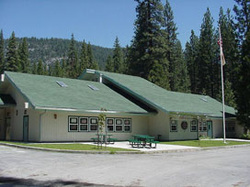
Dear Friends of Wawona School,
Our foundation is desperately trying to keep Wawona School open during the process of becoming an independent school district. Our school operating expenses plus our legal/consulting fees have been a necessary burden on our treasury. At this time we hope we can keep our school open to the end of this current school year.
If you have plans of making any end-of-the-year tax related contributions, please keep Wawona School in mind.
Our foundation's non-profit 501(c)(3) federal tax ID number is 20-1636147, and the foundation's address is:
Yosemite-Wawona Educational Foundation
P.O. Box 2101
Wawona, CA 95389
Thank you so much for your consideration and for your continued support!
Warmest regards, Michelle Stauffer and the Y-WEF Board Members:
Ed Mee
Max Stauffer
Chad Andrews
Lucy Royse
Greg Royse
Our foundation is desperately trying to keep Wawona School open during the process of becoming an independent school district. Our school operating expenses plus our legal/consulting fees have been a necessary burden on our treasury. At this time we hope we can keep our school open to the end of this current school year.
If you have plans of making any end-of-the-year tax related contributions, please keep Wawona School in mind.
Our foundation's non-profit 501(c)(3) federal tax ID number is 20-1636147, and the foundation's address is:
Yosemite-Wawona Educational Foundation
P.O. Box 2101
Wawona, CA 95389
Thank you so much for your consideration and for your continued support!
Warmest regards, Michelle Stauffer and the Y-WEF Board Members:
Ed Mee
Max Stauffer
Chad Andrews
Lucy Royse
Greg Royse
